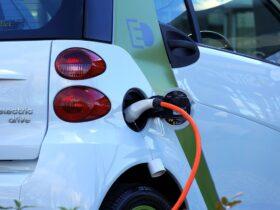- Connected infrastructure will facilitate more effective and efficient use of our roads and vehicles.
- It has the potential to revolutionize how we move, making road mobility more efficient, safer and cleaner.
- The ‘Automotive in the Software-Driven Era’ community has identified key actions crucial for unlocking the full potential of smart road transport infrastructure.
By Maria Alonso, Markus Hagenmaier and Ivan Butenko
Connected infrastructure has the potential to revolutionize how we move, making road mobility more efficient, safer and cleaner. Four key related use cases top the agenda for public-private collaboration:
1. Smart EV charging – accelerating electrification and contributing to cleaner air
Smart electric vehicle (EV) charging provides real-time data on charging station availability, optimizes charging schedules and provides a seamless experience. This, in turn, contributes to reducing charging uncertainty and accelerates EV adoption. It also contributes to a reduction in greenhouse gas emissions and air pollution.
2. Advanced traffic management – enhancing road safety and traffic efficiency
Information on real-time traffic and accident data can improve traffic flow and enhance road safety. By dynamically adjusting the timing of traffic light cycles we can optimize road capacity for the existing traffic and, using advanced traffic management, vehicles can be notified when objects are on the road.
3. Smart parking – saving time and reducing congestion
Smart parking utilizes real-time data from sensors and cameras to guide drivers to available parking spaces. Software-defined vehicles can get the necessary information to directly reserve and pay for a parking spot before reaching their destination. This reduces parking search, with the related time, congestion and emission benefits.
4. Intelligent tolls – optimizing road use and simplifying toll collection
Adaptive tolls facilitate the efficient steering of traffic flow. They can include variable pricing depending on, for example, congestion and pollution levels. Third-party transponders and licence plate recognition are used today for toll collection. Software-defined vehicles can provide a new toll collection mechanism, further integrating the toll collection process into the overall vehicle-to-everything (V2X) connected transportation system.

Key smart infrastructure use casesImage: World Economic Forum
These use cases become even more important when there is no human in the loop – that is, with the deployment of autonomous vehicles. Autonomous vehicles benefit from vehicle-to-infrastructure communication, ensuring safe and efficient mobility and facilitating parking, charging and toll collection.
Unlocking their value: 6 key actions
The Automotive in the Software-Driven Era community, part of the DRIVE-A initiative, has identified six key actions crucial for unlocking the full potential of smart road transport infrastructure and, with that, for reaping the potential benefits of the software-defined-vehicle ecosystem. These six actions are based on three principles, collaboration, innovation and efficiency:
1. Strive for stronger public-private collaboration
Advancing smart infrastructure requires a collaborative effort among involved players. Figure 2, below, provides a collaboration framework and key collaborative areas. Public-private partnerships help build a robust, cohesive and inclusive smart infrastructure network.
Paul Farrell, EVP and Chief Strategy Officer of BorgWarner highlights some of the challenges and importance of such collaborations: “Collaboration around the infrastructure is very complex and multidisciplinary. It involves questions about who owns the data, who supplies the hardware, who installs it and who integrates it into holistic solutions. Yet, it is key to, for example, advance the EV charging infrastructure that the transition to electrification requires.”

Collaboration framework to advance smart infrastructureImage: World Economic Forum, BCG analysis
2. Accelerate data accessibility
To unlock the benefits of smart infrastructure, data sharing is essential. For example, as Philippe Hahn, CTO and Global VP DevOps of Yunex Traffic, said: “Technology is already able to create a digital twin of road intersections and can inform cars and vulnerable road users about dangerous situations in real-time. But to leverage this technology in real-life deployments, we need collaborative data sharing.”
Three things contribute to accelerating data sharing: competitive win-win partnerships; agreement on the specific data that needs to be shared to create additional value; and, agreement on the data management and sharing processes.
There are already a few regional examples of data-sharing policies being implemented in the realm of EV charging (e.g., the Common European Energy Data Space). However, a holistic scaled approach is still to be developed.
Have you read?
- IEA: electric cars, clean energy policies to drive peak fossil fuel demand by 2030
- Energy transition: Getting our grids fighting fit for an electrified future
- Industrial electrification is a joint venture: why collaboration across sectors is key
3. Define unified standards for smart infrastructure
Unified standards and connectivity protocols are necessary to create a more interconnected transportation network. They allow for different players to provide services across various types of infrastructure, enabling stronger coverage and increased flexibility for users. Standardization can foster a cohesive and interoperable system that benefits industry and the public.
4. Increase integration between vehicles and their smart infrastructure ecosystem
Additional value can be created when there is a deeper integration between software-defined vehicles and their surrounding smart infrastructure. This integration leads to a more seamless user journey. MTR Lab is advancing such integration in Hong Kong: “We are creating a platform that provides an all-in-one parking solution. This includes searching and paying for parking with EV charging in shopping malls,” explained Michael Chan, Managing Director at MTR Lab.
Deep integration between vehicles and smart infrastructure also helps to close the ‘communication loop’ by allowing the ecosystem to collect feedback from users via the car’s human-machine interface to ensure more accurate data (e.g., availability of a parking spot).
5. Optimize infrastructure utilization
Smart infrastructure does not come cheap. Hence, ensuring optimized usage is key to reducing costs and increasing financial viability. This includes better design and location of smart infrastructure. Data is necessary to make informed decisions.
Fujitsu has a related recent experience: “We observed that considering energy mix and cross-sector data collaboration is a key to optimizing EV charging plans, which reduces CO2 emissions and realizes the decarbonization of transportation.
By pulling together data from different stakeholders, we simulated an optimal charging plan on a digital twin, enabling 15% CO2 reductions via higher green energy utilization and optimized charging patterns,” said Shunichi Ko, Senior Vice President, Head of Cross Industry Solution Business Unit at Fujitsu.
6. Ensure a targeted use-case collaboration
Even though many use cases require a systematic effort (e.g., having a data accessibility framework), a general approach to smart infrastructure has limited real-world implementation potential.
It is important that each collaboration addresses a concrete transport/ mobility challenge (e.g., EV charging for city delivery fleets or parking in highly congested areas). This targeted approach helps ensure a business case with clear societal and economic value, which facilitates funding and collaboration.
Link: https://www.weforum.org/agenda/2024/04/unlocking-the-value-of-connected-mobility-infrastructure/?utm_source=pocket_saves
Source: https://www.weforum.org
















Leave a Reply